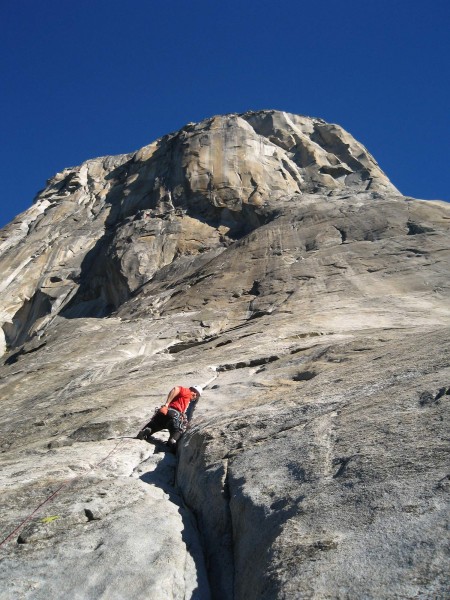El Capitan is one the most famous big walls in the World and considered by most climbers to be the best. It is the historical center of big wall climbing and continues to be the main place where big wall climbing standards are pushed to the next level. It is not the biggest climb in the world--there are bigger walls in Baffin Island--but it is one of the most continuously steep faces with the best rock. What makes El Capitan stand out is how accessible it is. Most other big walls of it's size are either too remote or don't have good enough rock to be a place where climbers gather and push each other. Even since the 1950's, many of the best climbers in the world have come to El Capitan to raise climbing standards and improve climbing equipment.
"As Denali, Mount Rainier and the Grand Canyon dominate and define their respective national parks, so does El Capitan loom, tower and rule over the entrance to Yosemite Valley. You can pick any synonym for “dominate” and it will still work. Overshadow. Domineer. Intimidate. Overwhelm. Not enough such words exist in our language to properly describe the effect this cliff exerts on climbers and tourists alike."
-//Steve Roper, Camp 4//
Most Popular Climbing Routes on El Capitan
The Nose
Salathe Wall
Zodiac
Lurking Fear
East Buttress
Triple Direct
Short History of the First Climb of El Capitan
The complete history of the first ascent is in Yosemite Big Walls
After missing a chance to make the first ascent of Half Dome, Warren Harding knew there was only one other accomplishment that could surpass it – the first ascent of El Capitan. Because no technical rock climb of this scale had ever been attempted, Harding employed expedition tactics of using supplied camps linked by fixed ropes. In addition, the Park Service mandated that the climbers use fixed ropes so that a rescue would not be necessary. On July 4, 1957, six days after the first ascent of Half Dome, Harding and his team began their historic journey.
On November 1, 1958, the team, now consisting of Harding, Merry, Rich Calderwood and George Whitmore, prusiked to their high point at 1,900 feet, and launched their summit campaign. The Great Roof, although appearing from the ground to be the crux of the route, was easily dispatched, and the climbers moved steadily up to Camp VI. At this point Calderwood suddenly dropped out, leaving Whitmore to move loads and Harding and Merry to swing leads up the spectacular upper dihedrals.
After enduring a storm on November 10, they reached a small ledge 180 feet below the summit. Above them loomed a blank and overhanging wall. At 6 p.m. the next day Whitmore came up the fixed ropes, which now spanned 2,800 feet of the wall, and delivered a fresh supply of bolts to Harding. What followed was described by Steve Roper in Camp 4 as “the most famous single episode in Yosemite’s illustrious climbing history.”
For 14 hours, from dusk till dawn, Harding endured the unimaginable pain of hand drilling 28 bolts in a row by Headlamp-Review-Review-Review-Review. At 6 a.m. he stood exhausted but triumphant on the summit, greeted by hordes of friends and media who created a huge commotion unlike that prompted by any previous climb. Scaling El Capitan had required 45 days of climbing over 18 months and had consumed 125 bolts. The triumph shook both the climbing and non-climbing worlds and would change big wall climbing forever. The term “impossible climb” would never again be used as easily. Within a few years the rush was on to climb in Yosemite.
El Capitan Links
Suggested Climbing Rack For El Capitan
El Capitan Web Cam
How to Big Wall Climb
Further Reading
Yosemite Big Walls
Camp 4
Ordeal by Piton
Complete Yosemite Reading List

